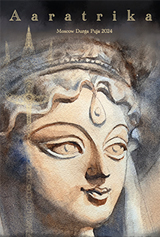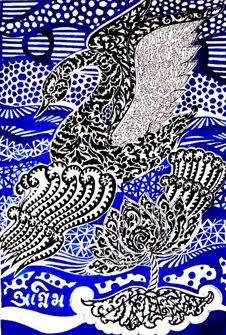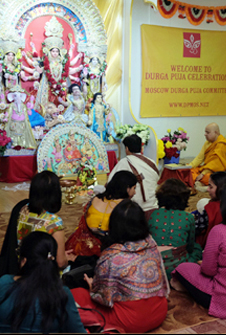Durga Puja in Kolkata 2025

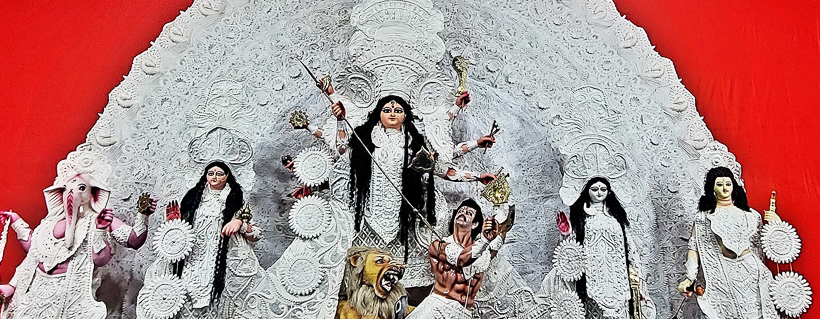
Durga Puja is the most important festival in the city of Kolkata. The festival celebrates the victory of good over evil as goddess Durga killed demon king Mahishasur. According to Hindu mythology, it is believed that the goddess visits her earthly abode during this time to bless her devotees. Durga Puja holds great significance for the Bengali community.
This festival is celebrated for five days and marked by prayers to goddess Durga, Feasts, Rejoicing, Music, Dance and Drama. Some say there are upwards of 4,000 Durga Puja pandals scattered throughout Kolkata, and attendance by millions of people. The Durga Puja Festival is the event that people of Kolkata and all Bengalis look forward to all year long.
In Bengali traditions, these deities are considered to be Durga's children, and Durga Puja is believed to commemorate Durga's visit to her natal home with her beloved children. The festival is preceded by Mahalaya, which is believed to mark the start of Durga's journey to her natal home.
The Story behind the Festival
According to the Hindu Mythology, Goddess Durga emerged from the collective energy of all the Kings and Gods (devas) as an embodiment of Shakti or divine feminine power, to destroy demon Mahishasura; who was blessed to not be defeated by any man or god. The name Durga in Sanskrit means 'the impenetrable'; she exists in a state of self-sufficiency and in ultimate power. This powerful form of Mother Goddess is highly revered in Kolkata which is why her return is celebrated with much grandeur and ceremonies. If you are in Kolkata during Durga Pooja, these are the popular features of the grand celebrations, you shouldn't miss out on. The preparations for the festival are as fascinating as the festival itself. A week prior to the festival, the city gears up and can be seen wearing a look of eagerness and excitement as it prepares itself to welcome the Goddess home.
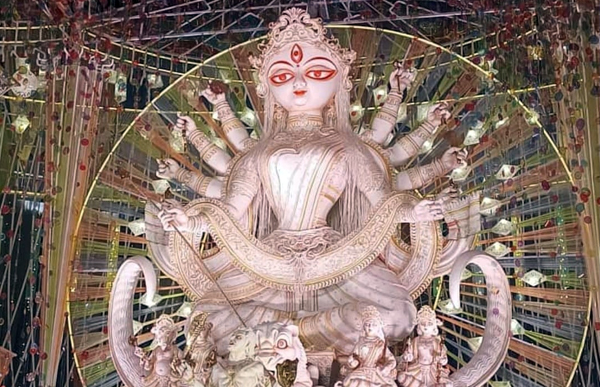
Rituals and Practice Observed
Rituals and Practice of Durga Puja Remain different from one religion to another. Kolkata follows its own sets of customs from the start of the festival until the end.
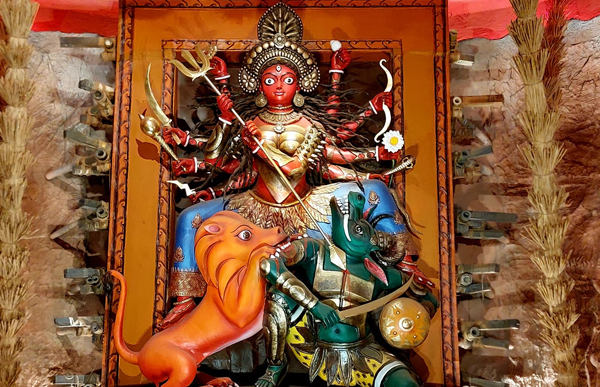
Chokkhu Daan - The Day When Eyes of Goddess Durga are Painted
Durga Puja in Kolkata has its own unique rituals. A week before Navratri begins; the idols of Goddess Durga are being painted and made ready except for the eyes. On the occasion of Mahalaya, the Goddess is invited on earth with rituals and so on this day, the eyes are drawn on the idols in an auspicious ritual called Chokku Daan. It is believed the Goddess descends to earth at the time of drawing the eyes on the idols. Kumartuli or potter's locality is a famous place in North Kolkata where a majority of the idols are made.
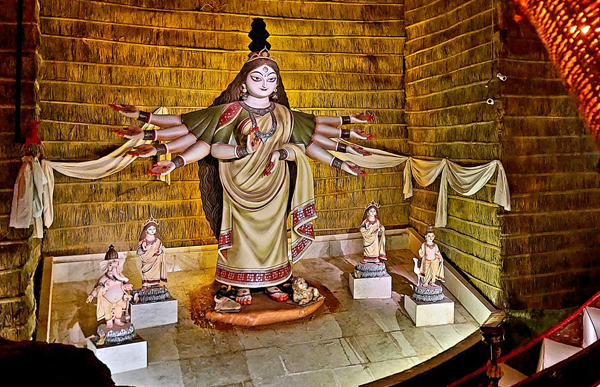
The Procession to Bring in the Deity
On the sixth day of Navaratri i.e. the first day of Durga Puja in Kolkata; the beautifully decorated idols are brought home or placed magnificently as decorated public pandals. The idol is then decorated with flowers, clothes, jewellery, red vermillion and various sweets are kept in front of the Goddess. The idol of the Goddess is accompanied by the idol of Lord Ganesh. Goddess Durga is considered to be Lord Shiva's wife Parvati's avatar and thus the mother of Lord Ganesh and his brother Kartikeya.
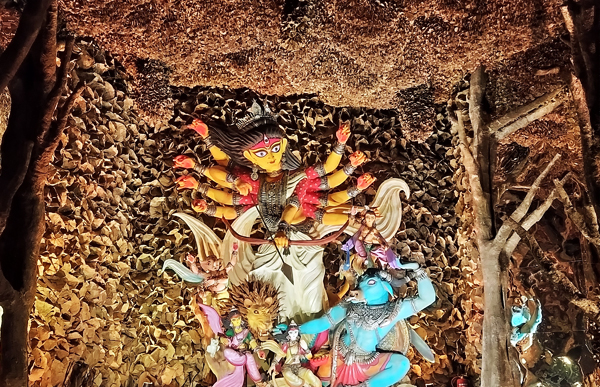
The Nabapatrika
Popularly known as Lord Ganesh's wife, Kolabou in reality has no relationship with Ganesh. Our scriptures call her Nabapatrika. Interestingly enough, Nabapatrika was actually a popular ritual performed by the peasant folks for prosperous harvest. As idol worship was not common then, people worshipped Mother nature. It was during the autumn (Sharat), the time for reaping crops ("Amondhan"), peasants worshipped Goddess Nabapatrika for good harvest. Later when Durga Puja became a popular festival of "Sharat", all the nine holy rituals of the Nabapatrika, were added to the ceremonies of Durga Puja. Infact Nabapatrika represented the primitive form of Durga Puja. This primitive form of worship is still prevalent in some places.
The Nine Plants comprising Nabapatrika are : Banana plant - "Kola Gaachh" Colacassia plant - "Kochu Gaachh" Turmeric plant - "Halud Gaachh" Jayanti tree - "Jayanti Gaachh" Wood apple tree - "Bel Ghaachh" Pomegranate tree - "Daalim Gaachh" Arum plant - "Maankochu Gaachh" Rice plant - "Dhaan Gaachh.
Nabapatrika being an important part of Durga Puja, is worshipped during Bodhon. The nine plants of Nabapatrika represent the nine Goddesses, the nine forms of Devi Durga. They are : The Banana plant represents Goddess Brahmani , Colacassia plant represents Goddess Kalika , Turmeric plant symbolises Devi Durga , Jayanti denotes Devi Koumari , Bel denotes Goddess Shivaa , Pomegranate represents Devi Raktadantika , Ashoka symbolises Shokrahita , Arum plant represents Chamunda ,Rice plant is for Goddess Lakshmi
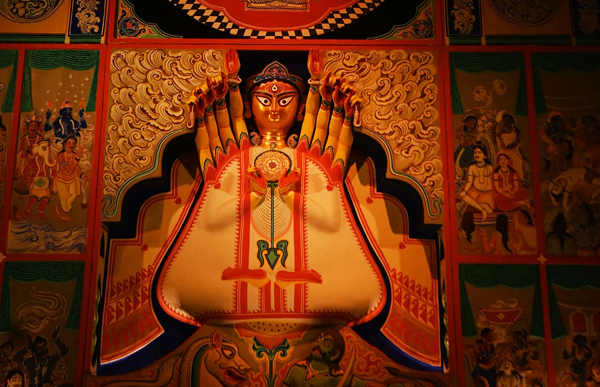
Bathing Ritual
In the early hours of Saptami, the twigs of white "aparajita" plant along with nine bunches of yellow threads are used to tie the Nabapatrika. It is then bathed. In our scriptures the elaborate bathing ritual of nabapatrika is compared with the coronation of a King. Just like the King is bathed with waters from holy places and oceans, bathing nabapatrika too requires the same. All the nine Goddesses representing nabapatrika are bathed with waters from 8 different holy places. This bathing ritual is accompanied with varied mantras and diverse musical instruments for different goddesses.
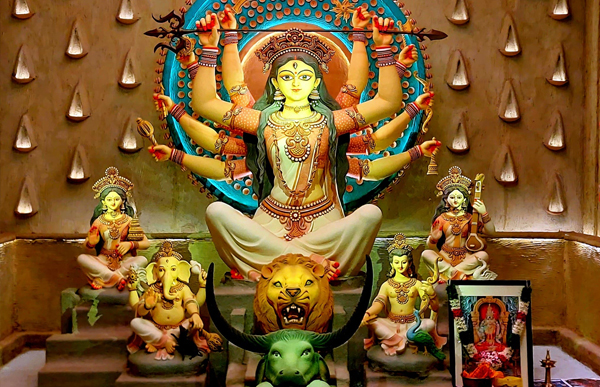
The Holy Waters and the Ragas
The first pot holds the holy water of the Ganges which is accompanied with Malob Raga. The second pot holds rain water which is accompanied with Lalit Raga. The third pot holds water from river Saraswati which is accompanied with Vibhash Raga with Dundhabi beats. The fourth pot holds ocean water which is accompanied with Bhairavi Raga with Bhim beats. The fifth pot holds mixture of Lotus pollen in holy water which is accompanied with Gaur Raga and mahendrabhishek beats. The sixth pot holds spring water which is accompanied with Barari Raga and sound of conch shell. The seventh pot holds water from all holy places which is accompanied with Vasant Raga and sound of conch shell. The eighth pot holds holy water which is accompanied with Dhanshirag Raga and Bhairavi beats.
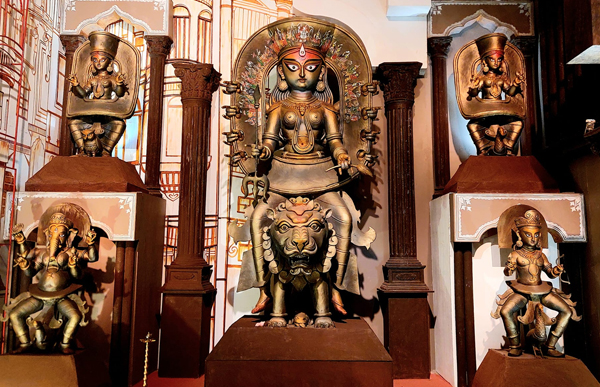
Kumari Puja
Goddess Durga arrives to her earthly abode with her two children - Kartik and Ganesh, and her two other forms - Laskhmi (wealth & prosperity) and Saraswati (knowledge). We worship her as the Goddess of Shakti who overpowered the evil to establish peace and prosperity on earth. She is also the daughter making her yearly visits at her parents place along with her children for four days. The Goddess is worshipped in various forms during her stay here. One of those forms is the "Kumari", the Virgin form. This mould is the most powerful form of Mahashakti. A girl aged between one to sixteen, symbolising the Kumari form of Devi is worshipped in front of the idol of Goddess Durga. The Kumari form of the Goddess was emphasised as the most dynamic form by the devotees since yester years as Kumari Shakti is the basis of all creations. Our scriptures have emphasised Kumari Puja particularly to evolve the purity and divinity of the women of the society. Diminishing the larger than life stature of the Goddess to someone much nearer and closer is the real reason for this form of worship. Sri RamKrishna had said that Kumari is another form of Devi Durga and he himself worshipped Sarada Ma as Kumari. To imagine the Goddess in the mould of a Kumari is an age old concept. In Mahabharata Arjuna had performed Kumari Puja. The Puranas mention the Kumari form of Chandika. This is also vividly and specifically mentioned in the "Kubjika Tantra".
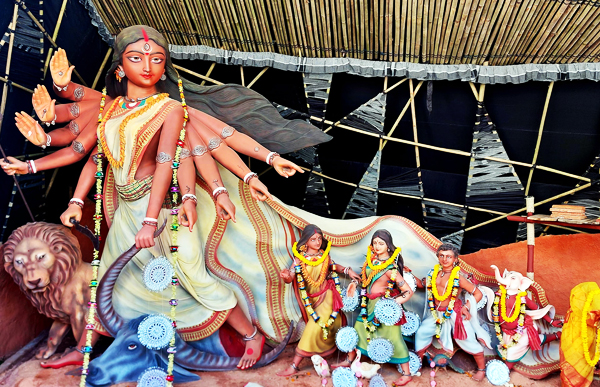
Selection of Kumari
The scriptures mention the great care with which the Kumari is selected to be worshipped as the earthly representative of Devi Durga. The qualities required in the girl has to match the dynamism, purity and serenity of the Goddess. A calm, serene and an unmarried girl with a bright disposition between one to sixteen years, who has not yet reached her puberty and is bereft of desire, worldly pleasures and anger is the right requisite for the Kumari Puja. Depending on the age of the girls they are worshipped in the various forms of the Goddess. A one year old girl is worshipped in the Sandhya form of the Devi while a two year old is worshipped in the Saraswati mould of the Devi. A three year old girl is worshipped in the Tridha form of Durga and a four year old is worshipped in the Kalika mould of the Devi. Subhaga and Uma are the forms of Durga for a five and a six year old respectively. Malini form of the Goddess represents a seven year old while Kujjika represents a eight year old girl. Kalsondarbha and Aparajita stands for a ten year old girl and an eleven year old girl. Bhairavi is represented by a twelve year old girl and Mahalakhmi by a thirteen year old girl. Pitnayika, Khetragya and Ambika by a fourteen, fifteen and sixteen year old girl respectively.
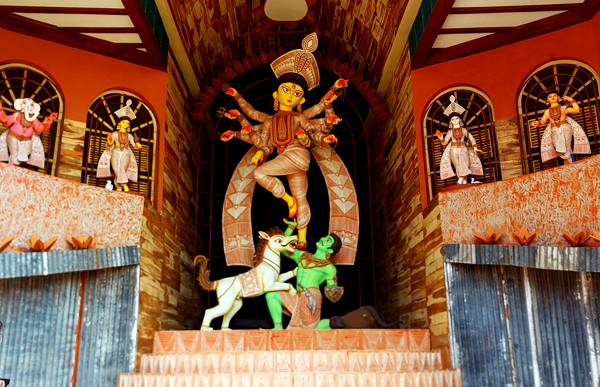
Worshipping the Kumari
Kumari Puja is held on Ashtami or sometimes Nabami. Kumari Puja is performed in Annapurna , Jagatdhatri and even Kali Puja as without Kumari Puja, the yagna remains incomplete. In the dawn of Ashtami or Nabami, the Kumari is bathed in Ganga water and is clad in a red benarasi saari. She is then adorned with flowers and jewelry, alta is applied to her feet and a 'tilak' of sindur on her forehead. The young Kumari fasts the whole day until the puja is over. On a decorated chair she is made to sit before the goddess and a flower from the Devi's hand is placed in her hand. Placed before her are flowers, bel (wood apple) leaves, incense sticks, lamps, 'noibiddo' and other things required for puja. The purohit then chants the mantras and the sound of dhak fill the atmosphere. After the puja the divinity of the Goddess Durga is said to be seen in the girl. It is customary to gift the girl with gold, silver and clothes. To gift the Kumari is considered to be a pious act. Kumari Puja is very much prevalent in Belur Math. In 1902, Swami Vivekananda performed Kumari puja for the first time in Belur. In the premises of the Math, in the mandap, in the presence of Sarada Ma, Swamiji worshipped nine Kumari girls. He offered pushpanjali at their feet, gave them sweets and 'dakshina' (gift). He touched their feet after the completion of the puja. Later with meditation and mantras he worshipped Sarada Ma as Goddess Durga. Kumari Puja, somewhere, is celebrated on the Ashtami, yet somewhere, on the Nabami.
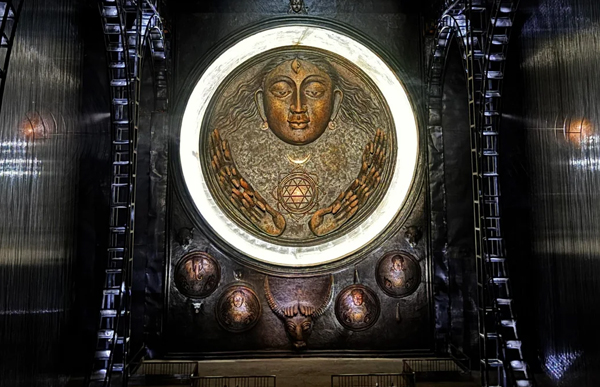
Sandhi Puja
An integral and important part of Durga Puja, Sandhi Puja, is performed at the juncture of the 8th and 9th lunar day. Sandhi puja lasts from the last 24 minutes of Ashtami till the first 24 minutes of Nabami. During this juncture (the "Sandhikhan"), Durga is worshipped in her Chamunda form. Devi Durga killed, Chando and Mundo, the two asuras at "Sandhikhan" and thus acquired the name of "Chamunda".
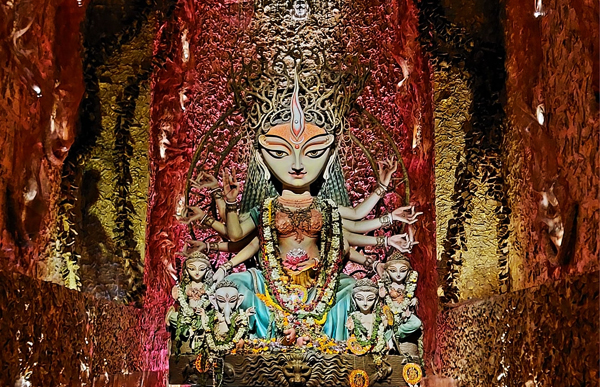
Dhunuchi Naach
Dhunachiis a Bengali incense burner (commonly used in conjunction with Indian Frankincense or "Dhuno" for traditional ceremonies) used for one of the stages during aarti, or ritualized dance worship.This devotional dance is performed to thank Goddess Durga by holding a dhunuchi, which contains the burning coconut husk with dhuno sprinkled on it. According to beliefs, before killing Mahishasura, Goddess Bhavani performed this dance to increase strength and energy.
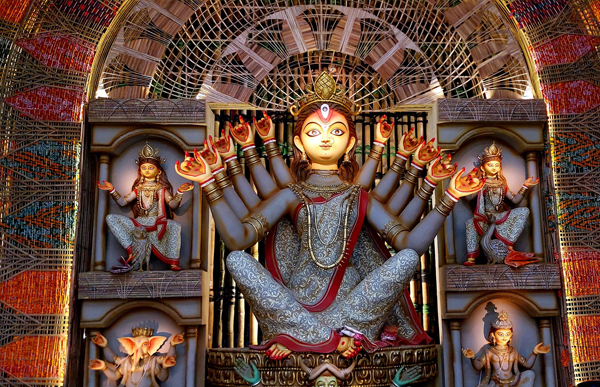
Dashami - The Last Day of the Durga Puja
The tenth day of the Durga Puja festival is called Dashami; it is believed that on this day, Goddess Durga gained victory over the Demon and thus restored the balance on the earth. It is also known as Vijayadashami. On this day, Goddess Durga is worshipped and offered many things as she is prepared to leave. Highly enthusiastic devotees gather in large numbers to join the procession that carries the Goddess to the ghats to be immersed in water. Babu Ghat is one of the popular places for immersion located near Eden Garden.
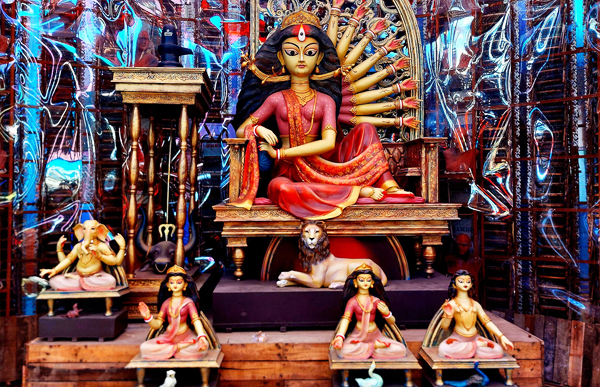
Sindur Khela
Women, especially married woman initiate the procession by first applying red sindoor or vermillion powder on the Goddess and then to each other. It is said to be a symbol of marriage and fertility.
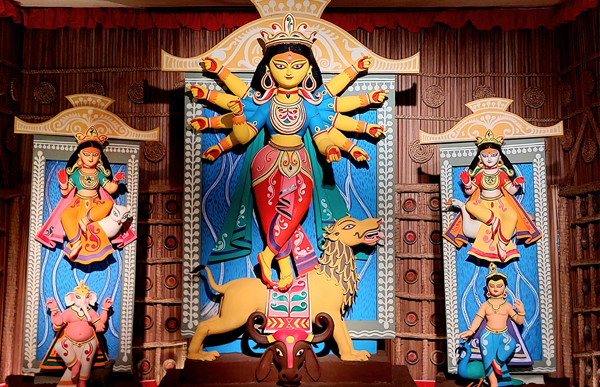
Pandals, Decorations and Food
The gorgeously decorated pandals each emphasize a theme; be it the legends of Goddess Durga or scenes from Hindu epic texts. Nowadays, some pandals are themed on a social cause to spread awareness. Day time is usually better to see the pandals closely when the crowd is less however; the brightly lit pandals in hundreds of colors is quite a sight of its own in the evenings.
Food is a major feature of the Kolkata Durga Puja festival and Kolkata is reputed to be a foodie's paradise. Sure enough, in a festival this grand you are bound to find the most delicious and incredible variety of Bengali cuisine. From snacks and sweet dishes that only Kolkata is famous for; to the Kolkata Durga Puja special themed Bhog meals that have a little of everything. All the pandals offer Bhog (offerings made to the Goddess Durga which is later distributed among the devotees) and community kitchens are also set up.
If you want to binge on the delicacies that the place offers, you may read Street Food of Kolkata.
This grand social event of Durga Puja showcases the beautiful culture of the Bengalis in India. The evenings during Kolkata Durga Puja witness the streets packed with thousands of people both locals and tourists alike who come to see the large beautifully decorated idols of Goddess Durga, to offer their prayers, eat at the numerous stalls that pop up in the streets and take part in the grand celebrations to honour the victory of Goddess Durga over evil.
Top Places of Durga Puja in South Kolkata
22 Pally - Northern Park
23 Pally
25 Pally Khidderpur
41 Pally Haridevpur
66 Pally
68 Pally
75 Pally
Adarshapalli Behala
Badamtola Ashar Songho
Babu Bagan
Balaram Bose Ghat Road
Behala Club
Behala Nutan Dal
Behala Sabuj Sathi
Behala Sree Sangha
Borisha Club
Bosepukur Parijat Club
Bosepukur Sitala Mandir
Bosepukur Talbagan
Ballygunge Cultural
Chetla Agroni Club
Chetla Sarbashadharaner
Deshapriya Park
Ekdalia Evergreen Club
Hindustan Club
Jodhpur park
Kasba Adhibashi Brindo
Khidderpore Palli Sharodiya
Maddox Square
Mudiali Club
Naktala Udayan Sangha
Pally Unnayan Samity
Padmapukur Youth Association
Samajsebi Sangha
Santoshpur Lake Pally
Santoshpur Trikonpark Sarbojanin Durgotsab
Shib Mandir
Selimpur Pally
Singhi Park Sarbojanin
Suruchi Sangha
Tridhara Sammilani
Vivekananda Park Haridevpur
Top Places of Durga Puja in Central and North Kolkata
Sealdah Railway Athletic Club
College Square Sarbojonin Durgotsab Committee
Md. Ali park (Youth Association)
Santosh Mitra square durga puja or Lebutala park
Manicktala Chaltabagan Lohapatty Durga Puja
Brindaban Matri Mandir
Karbagan Sarbojonin Durga Puja
Telenga Bagan Sarbojanin Durgotsab
Nalin Sarkar Street Sarbojanin Durgotsab
Hatibagan Sarbojanin
Hatibagan Nabinpally Sarbojanin Durgotsav
Sikdar Bagan Sadharan Durga Puja
Kashi Bose Lane Durga Puja Committee
Azad Hind Bag (Hedua Park Durga Puja)
Simla Byayam Samity
Jagat Mukherjee park
Sovabazar Rajbari
Ultadanga Yuba Brinda
Ahiritola Sarbojanin Durgotsab
Ahiritola Jubak Brinda
Sovabazar Beniatola Sarbojanin Durgotsab Samity
Kumartuli Park Sarbojanin Durgotsab Committee
Kumartuli Sarbojanin Durgotsab
Bagbazar Sarbojanin
Deshbandhu Ladies Park
Tala Barowari Durgotsab
Tala Park Prattay
Sree Bhumi Sporting Club
Dum Dum Park, Tarun Sangha
Dum Dum Park Sarbojanin
Dum Dum Park Bharat Chakra
Lake Town Adhibasi Brinda
Top Places of Durga Puja in Saltlake, Kolkata
AB Block
AD Block
AJ Block
AK Block
AH Block
BB Block
BD Block
BJ Block
BL Block
EC Block
FD Park
Laboni Estate
